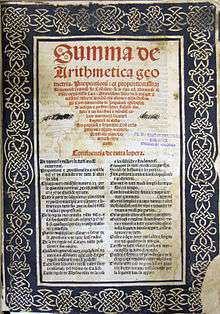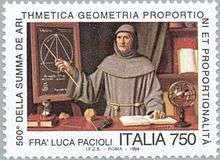Summa de arithmetica
 Title page of second (1523) edition | |
| Author | Luca Pacioli |
|---|---|
| Country | Republic of Venice |
| Language | Italian |
| Subjects | Mathematics, Accounting |
| Publisher | Paganini (Venice) |
Publication date | 1494 |
| Pages | 615 pp (first edition) |
Summa de arithmetica, geometria, proportioni et proportionalita (Summary of arithmetic, geometry, proportions and proportionality) is a book on mathematics written by Luca Pacioli and first published in 1494. It contains a comprehensive summary of Renaissance mathematics, including practical arithmetic, basic algebra, basic geometry and accounting, written in Italian for use as a textbook.
The Summa is the first printed work on algebra in a vernacular language, and it contains the first published description of the double-entry bookkeeping system.[1] It set a new standard for writing and argumentation about algebra,[2] and its impact upon the subsequent development and standardization of professional accounting methods was so great that Pacioli is sometimes referred to as the "father of accounting."[3]
Contents
The Summa de arithmetica as originally printed consists of ten chapters on a series of mathematical topics, collectively covering essentially all of Renaissance mathematics. The first seven chapters form a summary of arithmetic in 222 pages. The eighth chapter explains contemporary algebra in 78 pages. The ninth chapter discusses various topics relevant to business and trade, including barter, bills of exchange, weights and measures and bookkeeping, in 150 pages. The tenth and final chapter describes practical geometry (including basic trigonometry) in 151 pages.[4] The work was dedicated to Guidobaldo da Montefeltro, Duke of Urbino, a patron of the arts who Pacioli had met in Rome some years earlier.
The book's mathematical content draws heavily on the traditions of the abacus schools of contemporary northern Italy, where the children of merchants and the middle class studied arithmetic on the model established by Fibonacci's Liber Abaci. The emphasis of this tradition was on facility with computation, using the Hindu–Arabic numeral system, developed through exposure to numerous example problems and case studies drawn principally from business and trade. Pacioli's work likewise teaches through examples, but it also develops arguments for the validity of its solutions through reference to general principles, axioms and logical proof. In this way the Summa begins to reintegrate the logical methods of classical Greek geometry into the medieval discipline of algebra.[5]
Bookkeeping and finance
Within the chapter on business, a section entitled Particularis de computis et scripturis (Details of calculation and recording) describes the accounting methods then in use among northern-Italian merchants, including double-entry bookkeeping, trial balances, balance sheets and various other tools still employed by professional accountants. The business chapter also introduces the rule of 72 for predicting an investment's future value, anticipating the development of the logarithm by more than century.[6]
These techniques did not originate with Pacioli, who merely recorded and explained the established best practices of contemporary businesspeople in his region; still, the Summa's role in standardizing and disseminating professional bookkeeping methods has earned Pacioli a reputation as the "father of accounting."[3]
History and impact

Summa de arithmetica was composed over a period of decades through Pacioli's work as a professor of mathematics, and was probably intended as a textbook and reference work for students of mathematics and business, especially among the mercantile middle class of northern Italy.[4] The book was originally published in Venice in 1494 by Paganino Paganini,[7] with an identical second edition printed in 1523 in Toscolano.
While the Summa contained little or no original mathematical work by Pacioli, it was the most comprehensive mathematical text ever published at the time. Its thoroughness and clarity (and the lack of any other similar work available in print) made it a basic point of reference for European mathematicians through the sixteenth century and beyond.[5] The reputation the Summa earned Pacioli as a mathematician and intellectual inspired Ludovico Sforza, Duke of Milan, to invite him to serve as a mathematical lecturer in the ducal court, where Pacioli befriended and collaborated with Leonardo da Vinci.
The book also marks the beginning of a movement in sixteenth-century algebra toward the use of logical argumentation and theorems in the study of algebra, following the model of classical Greek geometry established by Euclid.[2] It includes the first printed example of a set of plus and minus signs that were to become standard in Italian Renaissance mathematics: 'p' with a tilde above (p̄) for "plus" and 'm' with a tilde (m̄) for minus.[4] Pacioli's assertion in the Summa that there was no general solution to cubic equations helped to popularize the problem among contemporary mathematicians, contributing to its eventual solution by Scipione del Ferro.
In 1994 Italy issued a 750-lira postage stamp honoring the 500th anniversary of the Summa's publication, depicting Pacioli surrounded by mathematical and geometric implements. The image on the stamp was inspired by the Portrait of Luca Pacioli, and contains many of the same elements.[8]
See also
- De divina proportione, another influential mathematical work by Pacioli
- Ars Magna, a subsequent landmark work of 16th-century mathematics
External links
- Ancient Double Entry Bookkeeping Part 11 of Paciolo's treatise translated into English by John B Geijsbeek, 1914. With original text.
References
- ↑ Swetz, Frank J; Katz, Victor J (January 2011). "Mathematical Treasures - Pacioli's Summa". Loci. Mathematical Association of America. Retrieved 28 January 2015.
- 1 2 Heeffer, Albrecht. From Problem Solving to Argumentation: Pacioli’s Appropriation of Abbacus Algebra (PDF) (Thesis). Ghent University. Retrieved 30 January 2015.
- 1 2 Smith, L Murphy (2011). "Luca Pacioli: The Father of Accounting". American Accounting Association. Retrieved 28 January 2015.
- 1 2 3 Sangster, Alan; Stoner, Gregory N; McCarthy, Patricia (June 2008). "THE MARKET FOR LUCA PACIOLI'S SUMMA ARITHMETICA" (PDF). Accounting Historians Journal. 35 (1): 111–134. Retrieved 29 January 2015.
- 1 2 Napolitani, Pier Daniele (2013). "Pacioli, Luca". Il Contributo italiano alla storia del Pensiero – Scienze (in Italian). Treccani. Retrieved 27 January 2015.
- ↑ O'Connor, John J; Robertson, Edmund F (March 2006). "A Napierian logarithm before Napier". MacTutor. University of St Andrews. Retrieved 29 January 2015.
- ↑ Nuovo, Angela (2014). "PAGANINI, Paganino". Dizionario Biografico degli Italiani (in Italian). 80. Treccani. Retrieved 27 January 2015.
- ↑ John F. Ptak (11 March 2008). "The Sovietesque Disappearance of Pacioli's Rhombicuboctahedron". JF Ptak Science Books. Retrieved 3 March 2015.